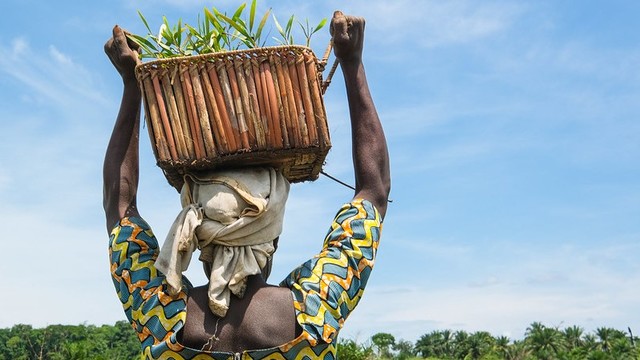Three asks to strengthen locally-led action in new biodiversity finance
When negotiators and experts met in Nairobi in June 2022 for the latest round of discussions on the post-2020 global biodiversity framework (GBF), mobilising finance to implement the strategy was a hot issue. But as Minnie Degawan and Ebony Holland highlight, discussions fell short because they failed to prioritise finance for local action.



Women involved in community meeting to discuss village reconstruction in Yogyakarta, Indonesia (Photo: Nugroho Nurdikiawan Sunjoyo/World Bank, via Flickr, CC BY-NC-ND 2.0)
To effectively implement the GBF – a new ten-year international strategy under negotiation to tackle nature loss – finance and decision-making power must shift to the local level to support locally-led action by Indigenous Peoples and local communities (IPLCs).
The second edition of the Convention on Biological Diversity’s (CBD) ‘Local Biodiversity Outlook’ notes that disregarding of the vital contributions of IPLCs to conservation and sustainable use contributed to the underachievement of the Aichi Biodiversity Targets. To avoid repeating this mistake, it is vital that IPLCs, including women, youth and farmers, are central to the GBF process and how the associated finance is designed and delivered.
Prioritising finance for local action
Despite an increase in finance pledges for specific actions and regions in recent years, research shows that national and global actors still control much of the finance and decision-making.
Not only does this fail to support locally-led actions, it serves as a barrier to sustainability, prevents the transformation of power dynamics and perpetuates colonial tendencies. And by excluding them from solutions to biodiversity loss and climate change, it also hastens the erosion of IPLCs’ diverse and rich knowledge systems.
The Nairobi meetings were meant to unlock critical blockages in finance and GBF resource mobilisation negotiations. But negotiators continued to focus on how much money is needed and who will provide it. Although these are key elements, they are only half the story. Ensuring finance is accessible, transparent and trackable, and that it supports quality outcomes, is just as important.
Lessons from roundtable discussions
At a roundtable side event in Nairobi convened by the IIFB and IIED, IPLCs, governments, researchers, funds and nongovernmental organisations got to the heart of these issues. And from this roundtable, we offer the following three lessons for strengthening the GBF finance negotiations ahead of the CBD’s 15th international conference on biodiversity (COP15).
1. IPLCs must have access to GBF financing
IPLC representatives noted that the international finance system is broken and money is not reaching them in the volumes required to support their priorities and needs.
For most funding, access requirements are too rigid for IPLCs and other local organisations. The application process is often unwieldy and in a foreign language, and monitoring and reporting requirements are time consuming and fail to consider local contexts. As a result, IPLCs often have to rely on costly international intermediaries, who retain the expertise and knowledge for accessing and managing finance, rather than directly accessing and managing it themselves.
Funders’ tendency to prioritise ‘high-value’ ecosystems is another major barrier for most Indigenous Peoples. At the roundtable, IPLCs called for nondiscrimination in financing, asking for funds to be made available to all IPLCs, who steward various ecosystems that, while not deemed ‘high-value’, are still extremely important for the world.
Over the coming months, GBF finance discussions must emphasise that funds will only have the desired impact if they are delivered in a way that is accessible for IPLCs. Failing to do so will undermine GBF implementation.
2. Financing must deliver quality outcomes
Roundtable participants also stressed that GBF funding must be delivered in ways that support quality outcomes. And, as the people who know the context best, IPLCs need to be at the centre of decisions over designing and delivering the finance. When external funders or organisations make these decisions, they do not reflect local knowledge, contexts, risks or opportunities.
Inclusive governance is crucial, as it helps ensure finance is structured in a way that is sensitive to IPLCs’ unique needs and can support multiple co-benefits across interconnected issues, such as nature, climate and inequality. So, it is vital that decision-making structures include IPLCs.
There are various examples of IPLCs being part of inclusive and equitable decision making over how international finance is delivered, and we need to see more of this.
Funds generally provide short-term finance, making it difficult for IPLCs to deliver long-term, sustainable change and address underlying issues. To support quality outcomes, funding must be longer term, more predictable, and seek to build IPLCs’ institutional capabilities while supporting mobilisation and building partnerships.
To date, GBF funding negotiations have been silent on these crucial issues.
3. Financing must be delivered transparently
At the roundtable, participants also highlighted the importance of transparency in the way GBF finance — and nature finance more broadly – is delivered. This is crucial for building trust, tracking where money goes and ensuring funders deliver on their promises. Greater transparency must be at the heart of GBF finance.
Applying these lessons
These issues are not exclusive to the GBF or nature finance. IIED's extensive climate finance research highlights similar issues. But there is a growing appetite for change, shown by more than 70 governments and organisations endorsing the principles for locally led adaptation.
Supporting IPLC-led initiatives in nature and biodiversity will also influence how finance is delivered for climate change, and vice versa.
Building on this roundtable, IIFB and IIED will continue to produce research for COP15 in December 2022 and will keep pushing to ensure IPLCs are central to deciding how GBF finance is designed, delivered, monitored and tracked. This approach is crucial to reverse our destructive relationship with nature over the coming decade.



